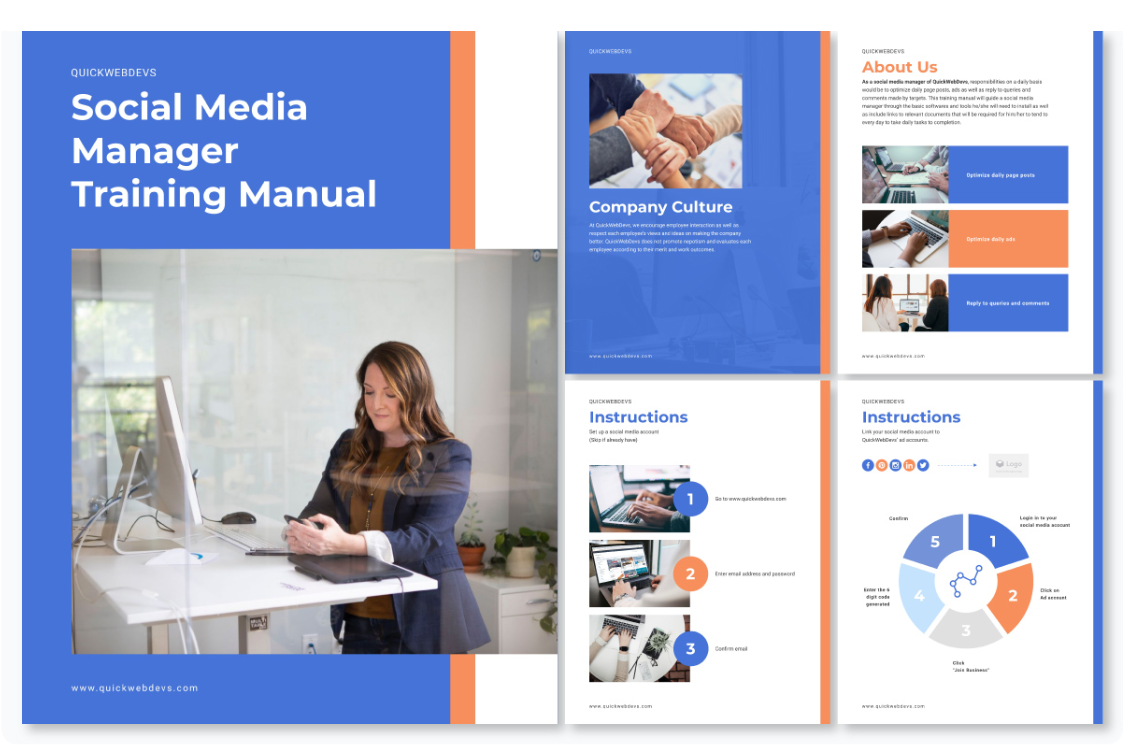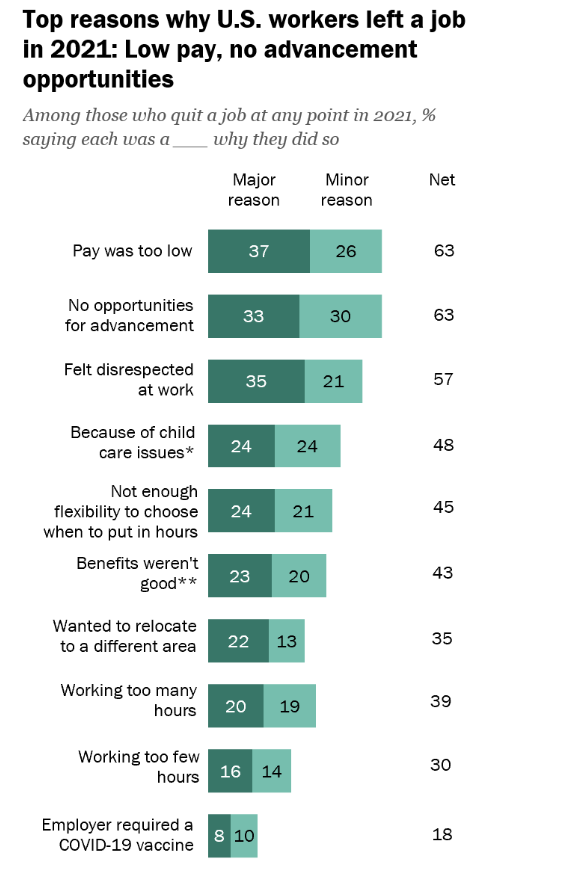Imagine navigating a dense forest without paths, signs, or so much as a map.
That's how employees feel when they don't have guidance or the right resources at work.
Now, picture someone handing you a detailed guide, compass, and backpack full of supplies—suddenly, the forest doesn't seem so daunting anymore. You have everything you need to thrive.
Just like these precious resources, an effective training manual can bridge the gap between confusion and confidence for your employees.
In this article, we'll show you how to create the same empowering effect with a well-crafted employee training manual.
What Is An Employee Training Manual?
An employee training manual is a comprehensive document that provides instructions and information, empowering employees to learn a skill, task, or job. It enhances learning and improves the quality of tasks and processes. There are different types of employee training manuals:
Self-Paced Guides
This type of employee training manual contains position-related information, empowering employees to do their jobs well or develop new areas of expertise.

Employee Handbooks
This type of employee training manual is what you give new hires to help them understand crucial information such as:
- Company vision, mission, and culture
- Workplace rules and conduct
- Legal obligations and expectations
- Employee rights
Task Manuals
These manuals provide specific task-related information and training. This may include training manuals that teach your employees how to carry out certain tasks like adding customers to a CRM or managing employees on a payroll system.
The Importance of an Employee Training Manual
If you're wondering why an employee training manual is such a game changer, we've outlined some key benefits below:
Increases Productivity And Engagement
When employees have the knowledge and skills to do their jobs, they're more productive and engaged. A structured onboarding process with effective resources (like manuals) can increase productivity by up to 70%, according to a Brandon Hall Group report.
But that's not all, research by Gallup states that an engaged workforce provides other distinct business outcomes, such as:
- 10% higher customer ratings
- 20% higher sales
- 21% higher profitability
Enhances Onboarding
The right employee training manual makes onboarding new hires more efficient. Instead of feeling overwhelmed and constantly seeking help, all the information needed to work confidently is readily available. A hassle-free onboarding experience adds to new hire satisfaction, increasing retention by up to 82%, as found by the previously mentioned Brandon Hall Group report.
Promotes Continuous Learning
Having a comprehensive employee training manual promotes continuous learning. Not only do employees gain vital, on-the-job skills, they're able to keep doing their jobs well and grow into other areas of responsibility.
An employee training manual also serves as an important reference point throughout an employee's tenure, reinforcing and nurturing their expertise. This focus on continuous learning means you're more likely to retain skilled staff over the long term, which further increases your bottom line.

Demonstrates Employee Investment
Training manuals are a great example of investing in employee learning and development. Not investing in the initial and ongoing development of your employees can have costly implications for your business. A Pew Research Center report reveals that 63% of employees who quit their jobs did so primarily because of a lack of advancement opportunities.
Reduces Errors
When you invest in training your employees, they're more likely to be confident and competent at their work, significantly reducing the possibility of costly mistakes. In addition, training manuals help establish standard operating procedures, promoting consistency and favorable business outcomes like better customer service.
Key Elements of an Employee Training Manual
The following elements are essential for an effective training manual:
- Clear goals and objectives: These define the manual's purpose and what employees should know after training.
- A clear and consistent structure: This ensures that the information provided in the manual is easy to understand and that employees know how to use it.
- Comprehensive resources and references: This includes recommended articles, websites, or books that provide additional information and enhance the learning process.
- Accessibility: This involves making manuals easy to find and use.
- A glossary: This includes definitions and explanations of any technical terms or jargon used in the manual.
How to Create an Employee Training Manual
1. Determine your Objectives
Clear objectives make for an effective manual, allowing you hone in on the skills you want to impart and how best to impart them. So, consider asking the following questions as your starting point:
- Who is your intended audience? Are you targeting new hires, existing employees or a specific department?
- What are you hoping to achieve by creating the training manual? Would you like to improve onboarding, teach certain skills or ensure compliance?
- What specific information, processes, or procedures do you need to cover?
2. Plan Content
After determining your objectives, plan your content. First, consider the type of training manual you want to create. This allows you to tailor your content to the purpose and objectives of your employee training manual.
If you're creating an employee handbook:
As mentioned earlier, an employee handbook helps new and existing employees carry out their duties effectively. It also clearly outlines their rights and responsibilities. So, it should include:
- Company policies on work, conduct, safety, and any other legal obligations
- Clear information on benefits, salary reviews, bonuses, and any other perks
- Key cultural practices or values employees should be aware of
- Important contacts in HR, IT, support, and other essential areas
If you're creating a task manual:
Focus on specific job functions or processes and include:
- Simple, clear, step-by-step instructions that break tasks into sequential steps
- Diagrams, photos, videos, or any other appropriate visual aids that enhance understanding and make content more engaging
- Tips and solutions for common problems employees may encounter
- Any tools, software, or resources needed to complete tasks and how to access them
If you're creating a guide:
As guides generally cover broader concepts or skills that employees need to develop to excel in their roles, focus on:
- Information and techniques that allow employees to learn new skills and reinforce existing ones.
- Incorporate self-assessment tools and activities that encourage active learning and self-reflection.
- Provide practical examples to demonstrate how skills can be applied in various roles.
- Include additional company resources so employees can experience progression in their learning journeys.
While the examples provided above are a great starting point, it's crucial to take your own organizational requirements and employee needs into consideration.
2. Choose The Right Format
Once you know what kind of manual you want to create, choose the right format to present your content. This might vary from digital PDFs, printed booklets, and interactive online guides to detailed video walkthroughs. The key is to consider what is most accessible, appropriate, and useful for your employees.
For example:
- Will you deliver your employee handbook as a shareable PDF, or as a series of articles in your internal knowledge base?
- Will you deliver employee training for new software as short videos or as step-by-step video guides?
Ultimately, the right format lets you present your content as digestible sections or modules (with clear learning objectives) for optimal engagement and knowledge retention.
3. Create Your Manual
Once you've finalized key details such as content and format, you can dive into actually creating your manual. While the process will vary depending on your chosen format, here are a few content creation best practices to keep in mind:
Understand your Audience
When crafting educational content, taking your audience's needs, preferences, and learning styles into account guarantees higher levels of engagement, comprehension, and ultimately, effectiveness.
Involve Key Stakeholders
Depending on the nature of your manual, you may need to gather insights and department-specific expertise. Consulting subject matter experts ensures that your manual is effective and meets the training needs of various areas throughout your company.
Focus On Structure and Organization
No matter what type of manual you're creating, a logical content structure is crucial for accessibility and effectiveness. Start with foundational concepts, gradually building up to more complex information and break complex processes up into simple steps.
Include Learning Aids
Visuals and interactivity are an essential part of modern training manuals. Use visual aids like images and videos to enhance learning and engagement. For greater impact, incorporate interactive elements such as worksheets and assessments that encourage employees to test their understanding.
4. Review Your Content
Before signing off on an employee training manual, a thorough review process is essential. A document review process goes beyond basic proofreading and includes:
- Fact-checking by subject matter experts
- Coherence checks by an experienced editor
- Input from key stakeholders such as department heads
- Pilot testing the manual with a small group of employees
Based on the feedback, make the necessary improvements and adjustments. This ensures that your employee training manuals are consistent, accurate, and aligned with company standards and values.
5. Leverage Technology
While the word ‘training manual’ tends to conjure images of a thick spiral-bound booklet, technology has revolutionized how these essential training materials are created and delivered. It's never been easier to craft engaging employee training manuals. That said, here are two must-have tools to boost your employee training efforts:
Workflow Documentation Tools
Workflow documentation involves creating records of your processes and procedures which can serve as valuable training manuals for employees. With tools like Wizardshot, you can eliminate time-consuming tasks like manually compiling screenshots or steps of your work processes. Wizardshot effortlessly captures your workflows, generating engaging step-by-step video guides and tutorials in seconds — all completely free.
Knowledge Base Tools
Knowledge base tools act as a centralized digital repository, optimizing the way your organization creates, manages, and shares knowledge. An internal knowledge base tool like Helpjuice ensures all your training manuals are secure and instantly searchable for a seamless employee learning experience. Moreover, Helpjuice provides other features such as article authoring, collaborative editing, and analytics to streamline manual creation and review.
6. Get Feedback
Once your employee training manual is live, actively seek out employee feedback. Key questions to ask include:
- What did employees find helpful?
- Were there any areas that were unclear or confusing?
Gathering this input from employees is crucial for understanding what's working and what needs improvement. It also ensures that your training manual is not only relevant, but effective.
Additionally, leverage analytics to uncover more insights about your training manuals. Analyzing key engagement metrics such as completion and bounce rates, reveals precisely where you can optimize content and the overall user experience.
7. Update Your Manual
Creating an effective employee training manual is only the first step. To guarantee its long-term value, keep your training manual up to date. That way, employees always have access to the latest company information, policies, or procedures. In turn, this prevents misinformation, confusion, and errors caused by outdated information.
Wizardshot: The Ultimate Employee Training Manual Wizard
With the steps and best practices we've discussed, you're well on your way to creating an engaging—and effective—employee training manual.
If you plan to deliver training content via tutorials and step-by-step guides, why not turbocharge your efforts with Wizardshot?
Simply download the browser extension, get to work, and let the magic happen!
Try Wizardshot (completely free) today.


.jpg)